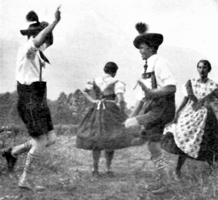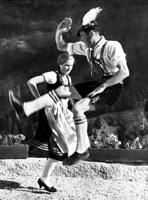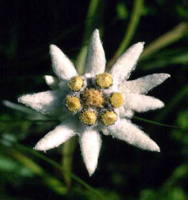
|
The Society of Folk Dance Historians (SFDH)
Schuhplattler
[
Home |
About |
Encyclopedia | CLICK AN IMAGE TO ENLARGE |

|
BACKGROUND
There are over 85 Groups (Vereine) in North America, and perhaps 800 in Europe (mostly Bavaria) organized to perform these dances, which are steeped in tradition and the culture of the region. The purpose of these groups is to preserve regional variations in these dances, costumes, music, language dialect, and song.
Translation: Shoe-slapping dance
Pronunciation: SHOOH-plaht-ler
Region: Bavaria Germany, Austria, and possibly other Alpine regions.
Note: Do not confuse Watschenplattler (smacking-slapping) with Schuhplattler. Watschenplattler are aberrations of the original Schuhplattler, derived by well-meaning but misguided individuals for pleasing/entertaining tourists. They are not "Echt" (true) to the "Heimat" (homeland).
 Most people at some time or another have seen the Schuhplattler (shoe slapping) or pictures of it without realizing its name or significance. The author, whose father was a founder and president of a leading Schuhplattler club in New York City, was exposed to it in his early youth without becoming fully aware of its full meaning.
Most people at some time or another have seen the Schuhplattler (shoe slapping) or pictures of it without realizing its name or significance. The author, whose father was a founder and president of a leading Schuhplattler club in New York City, was exposed to it in his early youth without becoming fully aware of its full meaning.
The Schuhplattler is not defined in Webser's dictionary, and one must have recourse to a German lexicon for its definition. Essentially, it is a coy courting dance, having its origin in the Bavarian and Austrian Alps many hundreds of years ago. The native Alpiners usually perform the dance on festive occasions. In America, we find Schuhplattler clubs in practically every large city, founded by conscientious groups who endeavor to keep the folk dance traditions alive as well as for social purposes.
An American depiction of the Schuhplattler is that of a "slap dance" because much of the dance involves slapping on the thighs, knees, and soles of the shoes by the male partner of a couple. Some people, however, prefer to call it a figuren tanz (figure dance), in view of the many figures enacted in the course of the dance. It is usually performed by a couple, the male partner called the bua or bursche, and the female partner, the madl or deandl. Moreover, when the dance is done by groups of couples, it is calle a gruppen tanz (group dance). The dance is set to the music of the Lándler (waltz), and always begins with an eingang (introduction of four musical measures).
It then proceeds into various figures, depending on the specific type of Schuhplattler. There are many types, each usually receiving its name from the town of origination – for example, der Haushammer from the town of Haushamm, der Sechsdorfer from Sechsdorf, etc. Other dances are: der Steirer Figuren Tanz (the Styrian's figure dance), Reit im Winkle (right in the corner), Watschen Plattler (waddling plattler), Heidauer (stamping), Kreuzschlag (regular lay), and Neubayerischer (new Bavarian). There are several hundred Schuhplattler dances known.
Some novelty dances have been devised, der Holzhacker (woodchopper dance) for example. It is performed by eight men, four with axes and four with large gang saws. These men saw and chop wood, generally a large tree trunk, to the music of the Holzhacker March, keeping in strict tempo. After several minutes of this activity, they engage in a plattler, slapping knees, thighs, and soles, also to the strict tempo of the March.
Another version is the Dreisteyrer (three Styrians), performed by two woman and a man. The latter transfers his affection in pantomime fom one lady to the other, thus arousing their jealous spirits. This is also performed in Waltz time. A reversal of the above is the Watschen Plattler (waddling plattler), done by two men and a woman. In this one, the men slap each other in a pantomime love duel over the women. The effect is quite realistic – the men have a merry battle over the woman with the outcome that one finally wins her affection.
One of the most beautiful group Schuhplattlers is the Reifen Tanz (tires dance), performed by eight, twelve, or sixteen couples, each holding a highly decorated bough between them, forming an arch. Circles or stars, crowns, and other intricate group formations follow through the patterns of this novel dance.
There also is a dance analogous to the May Dance, called der Bandel Tanz (the ribbon dance), and centers about a pole with the dancers holding blue and white streamers from the crown. They pass the ribbons over and under each other's bodies to form a beautifully meshed ribbon designs. There are other dances too numerous to mention here.
The Schuhplattler costume is unique and distinctive. The Germans and Austrians call it a tracht, and in their native lands, many Trachten Vereine (costume societies) are found. The men all wear the well-known short leather pants made from Gemselleder (chamois or mountain deer leather) held up by leather straps or suspenders with beautifully embroidered floral designs and commonly containing a hand-carved hartshorn (horn of a male red deer) ornament. The stuetzel (stockings) are made of wool and long or short according to the season. A green or red velvet vest plus a heavy grey jacket make up the outer garments. A green hat, plumed with an eagle or other type of feather, completes the male costume. The wel-to-do Alpiner usually has a large chain adorned with silver coins strung from one vest pocket to the other.
 The feminine tract is a richly decorated costume – broad skirt of cashmere, full in length and varied in color. Stockings are white and usually of cotton. A luxurious shawl drapes the upper body, folding into a meider (bodice) that resembles a snug-fitting vest. It has either buttons down the front or is hooked and usually is of velvet, and colored black. An apron matches the shawl and is extended in the hand during the Schuhplattler dance. The head covering is also a hat plumed with eagle feathers. Several edelweiss flowers are worn in both costumes, embroidered on, or in the hats. This is the famous rare white flower in the high Alps and, to the native Alpiner, is as symbolic as the various state flowers are to Americans in these United States. The pluck Alpiner risks his live many times to secure this flower for his sweetheart. Another flower associated with this costume is the gentian.
The feminine tract is a richly decorated costume – broad skirt of cashmere, full in length and varied in color. Stockings are white and usually of cotton. A luxurious shawl drapes the upper body, folding into a meider (bodice) that resembles a snug-fitting vest. It has either buttons down the front or is hooked and usually is of velvet, and colored black. An apron matches the shawl and is extended in the hand during the Schuhplattler dance. The head covering is also a hat plumed with eagle feathers. Several edelweiss flowers are worn in both costumes, embroidered on, or in the hats. This is the famous rare white flower in the high Alps and, to the native Alpiner, is as symbolic as the various state flowers are to Americans in these United States. The pluck Alpiner risks his live many times to secure this flower for his sweetheart. Another flower associated with this costume is the gentian.
A few other observations on the dance are worth mentioning. One could say that it is an open display of male "show-off." This is evident when in some of the dances the man turns sommersaults before the woman, indulges in cartwheels, stands on his head, or even rolls on the floor. It is also said that it is imitation of the antics of the courting auerhan (a large bird native to Europe).
Occasionally, during the Schuhplattler, the man gives out with a juchezer (woo-hoo) and kicks the woman's skirt into the air displaying her pretty knees, legs, and laced panties. At times, he even crawls under the skirt while she turns unconcernedly in small circles. At the conclusion of the dance, he lifts her high in the air as if to signify he has won her affection and love.
The music for the Schuhplattler is simple and lively. The harmony consists of major chords and their dominant seventh changes, alternating usually every second or third measure. Never is a Schuhplattler played in a minor key. In Europe, the zither, zieharmonika (accordion), and guitar in small ensembles are usually used to accompany the dancers. The music is predominantly in Waltz time, and the plattler as well as the stamping follows the accents in the musical notation quite rapidly. This is usually followed by an ausgang (output) of eight measures, consisting of a traditional melody.
Excerpts from an article titled Schuplattler by John T. Milek, Los Angeles.
Printed in Let's Dance!, May 1952.
RULES FOR COLLECTING OR LOOSING OF POINTS IN PRIZE SCHUHPLATTLING
These are the rules that are followed in the prize plattling that takes place yearly at some town in the United States or Canada, usually one that is celebrating an anniversary.
- The plattler will be chosen by each person in charge of their group. No figure dance will be considered as a plattler.
- Each group will be limited to no more than six couples.
- The manner in which the plattler is performed is at the discretion of each individual group. Uniformity in the men and women are essential. Additional stamps or hits, however, will result in the loss of points.
- Once a group is on the floor, calling to the music for any reason will result in the loss of points.
- Once a group is on the floor, adjusting of the tracht (costume) is not allowed and it will result in the loss of points.
- If a person looses a hat, apron, or any part of the tracht while on the floor, it will result in the loss of points.
- If any of the men's socks slip down while plattling, it will result in the loss of points.
- Fanning of women, such as kicking their skirts, is forbidden and will result in the loss of points.
- Once the group has started plattling, it can not stop for any reason until the plattler is completed. Otherwise, there will be a loss of points.
- Men must finish the dance with the same woman with which he started (unless there is a complete change throughout the group) or there will be a loss of points.
- If there is any talking during plattling or waltzing there will be a loss of points.
- If a situation should arise that conversation with the music is required, only the vorplattler (head man plattler) can converse with the musician. Others doing so will result in the loss of points.
DOCUMENTS
- Austria, a country.
- Dave Rosenberg, an article.
- Germany, a country.
- Morry Gelman, an article.
- Paul & Gretel Dunsing, an article.
This page © 2018 by Ron Houston.
Please do not copy any part of this page without including this copyright notice.
Please do not copy small portions out of context.
Please do not copy large portions without permission from Ron Houston.
